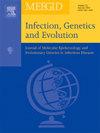Characterisation of M. tuberculosis isolates obtained from Tamil Nadu prevalence survey by whole genome sequencing analysis
IF 2.6
4区 医学
Q3 INFECTIOUS DISEASES
引用次数: 0
Abstract
Recent advances in whole genome sequencing have facilitated the understanding of drug resistance patterns and lineage distribution of M. tuberculosis worldwide. In this study, we aimed to determine the genetic diversity of MTB isolates from presumptive pulmonary TB patients obtained from a state prevalence survey. A total of 124 isolates were available for further characterisation, out of which 71 (57.2 %) and 47 (37.9 %) were subjected to sequencing and phenotypic DST, respectively. The phenotypic resistance profile revealed 3 isolates with multidrug resistance and 3 with mono-INH resistance. Out of 71 isolates, sequencing data were available for 61 (85.9 %), where the lineage distribution and drug resistance profile were analysed in comparison with phenotypic DST results. All the mutations were significant, accounting for one or the other resistance pattern. The concordance between pDST and gDST for the drugs was above 90 % except for ETH (77 %) and INH (87 %). The phylogenetic analysis of the lineage distribution revealed three clusters with MDR isolates belonging to lineage 1 and lineage 3. While lineage 2 is more frequently associated with MDR distribution both in India and worldwide, we did not find any lineage 2 MDR-TB isolates in our study. The use of WGS analysis improved our understanding of the genetic characteristics of MTB and its correlation with DR-TB transmission.
泰米尔纳德邦流行病学调查中结核分枝杆菌分离株的全基因组测序分析
全基因组测序的最新进展促进了对全球结核分枝杆菌耐药模式和谱系分布的了解。在这项研究中,我们旨在确定从州流行调查中获得的推定肺结核患者中分离出的结核分枝杆菌的遗传多样性。共有124株菌株可用于进一步鉴定,其中71株(57.2%)和47株(37.9%)分别进行了测序和表型DST。表型耐药谱显示3株为多药耐药,3株单药耐药。在71株分离株中,61株(85.9%)可获得测序数据,并与表型DST结果进行了谱系分布和耐药谱分析。所有的突变都是显著的,说明了一种或另一种抗性模式。除ETH(77%)和INH(87%)外,其余药品的pDST与gDST的一致性均在90%以上。谱系分布的系统发育分析显示,MDR分离株分别属于谱系1和谱系3。虽然在印度和世界范围内,谱系2与耐多药分布更频繁地相关,但我们在研究中未发现任何谱系2耐多药结核分离株。WGS分析的使用提高了我们对MTB遗传特征及其与耐药结核病传播的相关性的理解。
本文章由计算机程序翻译,如有差异,请以英文原文为准。
求助全文
约1分钟内获得全文
求助全文
来源期刊

Infection Genetics and Evolution
医学-传染病学
CiteScore
8.40
自引率
0.00%
发文量
215
审稿时长
82 days
期刊介绍:
(aka Journal of Molecular Epidemiology and Evolutionary Genetics of Infectious Diseases -- MEEGID)
Infectious diseases constitute one of the main challenges to medical science in the coming century. The impressive development of molecular megatechnologies and of bioinformatics have greatly increased our knowledge of the evolution, transmission and pathogenicity of infectious diseases. Research has shown that host susceptibility to many infectious diseases has a genetic basis. Furthermore, much is now known on the molecular epidemiology, evolution and virulence of pathogenic agents, as well as their resistance to drugs, vaccines, and antibiotics. Equally, research on the genetics of disease vectors has greatly improved our understanding of their systematics, has increased our capacity to identify target populations for control or intervention, and has provided detailed information on the mechanisms of insecticide resistance.
However, the genetics and evolutionary biology of hosts, pathogens and vectors have tended to develop as three separate fields of research. This artificial compartmentalisation is of concern due to our growing appreciation of the strong co-evolutionary interactions among hosts, pathogens and vectors.
Infection, Genetics and Evolution and its companion congress [MEEGID](http://www.meegidconference.com/) (for Molecular Epidemiology and Evolutionary Genetics of Infectious Diseases) are the main forum acting for the cross-fertilization between evolutionary science and biomedical research on infectious diseases.
Infection, Genetics and Evolution is the only journal that welcomes articles dealing with the genetics and evolutionary biology of hosts, pathogens and vectors, and coevolution processes among them in relation to infection and disease manifestation. All infectious models enter the scope of the journal, including pathogens of humans, animals and plants, either parasites, fungi, bacteria, viruses or prions. The journal welcomes articles dealing with genetics, population genetics, genomics, postgenomics, gene expression, evolutionary biology, population dynamics, mathematical modeling and bioinformatics. We also provide many author benefits, such as free PDFs, a liberal copyright policy, special discounts on Elsevier publications and much more. Please click here for more information on our author services .
 求助内容:
求助内容: 应助结果提醒方式:
应助结果提醒方式:


